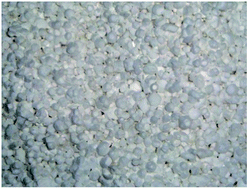The preparation of energy-absorbing material by using solid waste†
Abstract
In order to develop a new energy-absorbing material by using solid waste, a basalt fiber reinforced lightweight aggregate–geopolymer based cellular material (BFRLGCM) is prepared. A quasi-static compression experiment was carried out, the stress–strain curves were calculated, the ideal energy-absorbing efficiency was analyzed and the material’s prospects and feasibility of application have been explored. The results show that: the fiber reinforced cellular material prepared on the basis of Dense Packing Theory has successively sized pore structures; the stress–strain curve of the smaller specimen has three stages: the elastic stage, yielding plateau stage, and dense stage, and the dense strain is 0.646; the greatest value of the ideal energy-absorbing efficiency of BFRLGCM is 90.4%, which suggests BFRLGCM has excellent energy-absorbing properties. Thus it can be seen that the raw materials for BFRLGCM are abundant, the manufacturing cost is low, and BFRLGCM is easy and simple to make. With high plasticity, low density and excellent energy-absorbing features, BFRLGCM is a promising energy-absorbing material especially for use in civil defense engineering. What’s more, BFRLGCM has unique economical, social and environmental advantages, and the application of BFRLGCM can improve the utilization of solid waste, turning waste into wealth and so realizing a double win.


 Please wait while we load your content...
Please wait while we load your content...